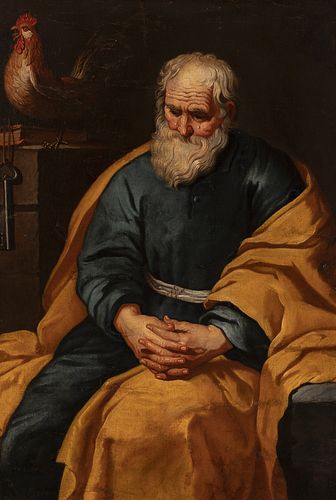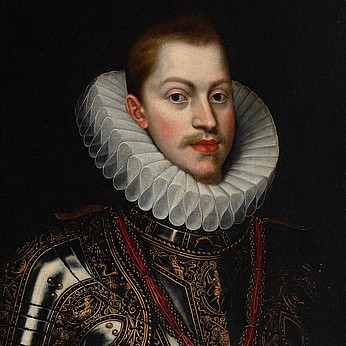Circle of GERARD SEGHERS (Flanders, 1596 - 1651). "St. Peter penitent." Oil on canvas adhered to tablex.
Lot 82
About Seller
Setdart Auction House
Carrer Aragó 346
Barcelona
Spain
Setdart Subastas was born in 2004 and is currently the first online art auction in Spain with solidity, prestige and reliability guaranteed by our more than 60,000 users. Setdart has a young, dynamic and enterprising team ready to successfully manage the purchase and sale of art works through custom...Read more
Estimate:
EUR€10,000 - EUR€12,000
$10,752.69 - $12,903.23
Absentee vs Live bid
Two ways to bid:
- Leave a max absentee bid and the platform will bid on your behalf up to your maximum bid during the live auction.
- Bid live during the auction and your bids will be submitted real-time to the auctioneer.
Bid Increments
| Price | Bid Increment |
|---|---|
| EUR€0 | EUR€10 |
| EUR€200 | EUR€25 |
| EUR€500 | EUR€50 |
| EUR€1,000 | EUR€100 |
| EUR€3,000 | EUR€200 |
| EUR€5,000 | EUR€500 |
| EUR€10,000 | EUR€1,000 |
| EUR€20,000 | EUR€2,000 |
| EUR€50,000 | EUR€5,000 |
About Auction
By Setdart Auction House
Nov 24, 2021
Set Reminder
2021-11-24 09:00:00
2021-11-24 09:00:00
America/New_York
Bidsquare
Bidsquare : Old Masters, Day 1
https://www.bidsquare.com/auctions/setdart-auction-house/old-masters-day-1-7873
Setdart Auction House sofia@setdart.com
Setdart Auction House sofia@setdart.com
- Lot Description
Circle of GERARD SEGHERS (Flanders, 1596 - 1651). "St. Peter penitent." Oil on canvas adhered to tablex. Measurements: 108 x74 cm; 115 x 82 cm (frame). This work faithfully reproduces the pictorial model created by Gerard Seghers, in his work Saint Peter Repenting, realized between 1624-1629, and that today belongs to the collection of the Louvre Museum in Paris. The canvas depicts the prince of the apostles, St. Peter, facing the viewer, but with his face tilted downward in a gesture of sorrow. The saint is easily identified thanks to his usual iconographic features: he has a prominent bald head, gray hair and a short beard. In addition, in the left zone of the composition, the keys can be distinguished, emblem of his power on earth and heaven, granted by Christ, and the rooster in allusion to his betrayal of Christ in front of the Roman soldiers. The author has used a chromatic range of brilliant tonalities, such as the blue of the tunic and the orange of the mantle, colors that contribute a great plasticity to the scene and a resounding definition of the forms. As a result, in this canvas we see a colossal St. Peter, with broad shoulders and a relatively small head, with protruding and marked cheekbones. It is a heavy figure, well constructed at the level of volumes, in a twisted posture, as he is seated. St. Peter (Bethsaida, c. 1 BC - Rome, 67) was, according to the New Testament, a fisherman, known to be one of the twelve apostles of Jesus. The Catholic Church identifies him through the apostolic succession as the first Pope, based, among other arguments, on the words addressed to him by Jesus: "You are Peter, and on this rock I will build my Church, and the power of Death shall not prevail against it. I will give you the keys of the Kingdom of Heaven. Whatever you bind on earth shall be bound in heaven, and whatever you loose on earth shall be loosed in heaven." St. Peter could be said to have been Jesus' confessor, his closest disciple, both being united by a very special bond, as narrated in both the canonical and apocryphal Gospels. As already mentioned, this work can be related to the artistic circle of Gerard Seghers, a Flemish Baroque painter, who was also one of the most outstanding caravaggists of the Southern Netherlands. He cultivated both historical and mythological genres, but it is religious painting to which he devoted himself most assiduously and of which the greatest number of works have been preserved. n Rome he came into contact with the followers of Caravaggio and in particular with Bartolomeo Manfredi, whose influence is felt in the best known of Seghers' works of this period. Although the artistic environment of the city seemed to be dominated by the painting of Peter Paul Rubens, Seghers remained faithful at first to Caravaggian tenebrism and its strong light effects.
- Shipping Info
-
In-house shipping available. Please inquire at admin@setdart.com.
-
- Buyer's Premium



 EUR
EUR CAD
CAD AUD
AUD GBP
GBP MXN
MXN HKD
HKD CNY
CNY MYR
MYR SEK
SEK SGD
SGD CHF
CHF THB
THB














